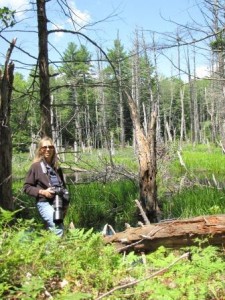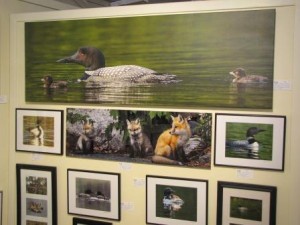ArrayNovember 9, 2015 at 12:49 pm
[caption id="attachment_1309" align="alignleft" width="225"] HERON volunteer, Linda Panzera, with camera in hand while observing a great blue heron colony.[/caption]
One of the best aspects about running a citizen science program such as the Heron Observation Network is meeting and regularly interacting with over 100 volunteers from all walks of life, who live all over the state (and out of state), and who share a passion for and fascination with the natural world. One such volunteer I’d like to highlight is Linda Panzera. She has been monitoring great blue heron colonies for HERON since 2010. As with all of my volunteers, I greatly appreciate Linda’s commitment over the years, her willingness to schlep across fields and forest to a mosquito-infested wetland to observe nesting herons in the heat of the summer, and her positive interactions with colony landowners that enable us to continue monitoring these sites over time.
Linda is a talented photographer living in Sebago. She is also a loon monitor for Maine Audubon, and keeps close tabs on nesting eagles for Maine Department of Inland Fisheries and Wildlife (MDIFW). She focuses her camera lens on all things nature, capturing gorgeous landscapes, vibrant wildflowers, adorable fox kits, and majestic eagles. Through photography, she observes and documents wildlife in their natural settings and at different stages of their lives. She loves to use photography to share the natural beauty of the world, as well as the connection she feels to her wildlife subjects.
And that’s not all she shares. Since 2010, Linda has been donating 5% of her photography company's earnings to MDIFW’s Nongame and Endangered Species Fund. This little known fund is responsible for most of the research and conservation efforts focused on nongame species in Maine, including but not limited to great blue herons, bats, and bumblebees. This fund is the primary source of state funding for Endangered, Threatened, and nongame wildlife in Maine. Every dollar in the fund is worth a whole lot more because it can be used to leverage double or triple the amount in federal matching funds. According to Linda, many of her customers like the fact that they are contributing to this fund by purchasing her photographs.
[caption id="attachment_1310" align="alignleft" width="300"]
HERON volunteer, Linda Panzera, with camera in hand while observing a great blue heron colony.[/caption]
One of the best aspects about running a citizen science program such as the Heron Observation Network is meeting and regularly interacting with over 100 volunteers from all walks of life, who live all over the state (and out of state), and who share a passion for and fascination with the natural world. One such volunteer I’d like to highlight is Linda Panzera. She has been monitoring great blue heron colonies for HERON since 2010. As with all of my volunteers, I greatly appreciate Linda’s commitment over the years, her willingness to schlep across fields and forest to a mosquito-infested wetland to observe nesting herons in the heat of the summer, and her positive interactions with colony landowners that enable us to continue monitoring these sites over time.
Linda is a talented photographer living in Sebago. She is also a loon monitor for Maine Audubon, and keeps close tabs on nesting eagles for Maine Department of Inland Fisheries and Wildlife (MDIFW). She focuses her camera lens on all things nature, capturing gorgeous landscapes, vibrant wildflowers, adorable fox kits, and majestic eagles. Through photography, she observes and documents wildlife in their natural settings and at different stages of their lives. She loves to use photography to share the natural beauty of the world, as well as the connection she feels to her wildlife subjects.
And that’s not all she shares. Since 2010, Linda has been donating 5% of her photography company's earnings to MDIFW’s Nongame and Endangered Species Fund. This little known fund is responsible for most of the research and conservation efforts focused on nongame species in Maine, including but not limited to great blue herons, bats, and bumblebees. This fund is the primary source of state funding for Endangered, Threatened, and nongame wildlife in Maine. Every dollar in the fund is worth a whole lot more because it can be used to leverage double or triple the amount in federal matching funds. According to Linda, many of her customers like the fact that they are contributing to this fund by purchasing her photographs.
[caption id="attachment_1310" align="alignleft" width="300"] Linda Panzera's photographs are on display at Gallery 302 in Bridgton. She donates 5% of her proceeds to the Nongame and Endangered Wildlife Fund.[/caption]
MDIFW is extremely grateful for Linda’s stewardship of Maine’s wildlife, her talent as a photographer that brings wildlife and nature into others’ lives, and her extraordinary generosity to the Nongame and Endangered Species Fund.
There are many ways you too can support research and conservation of Maine’s nongame wildlife: purchase a Loon License Plate or Sportsman License Plate, contribute to the Chickadee Check-off on your income tax return, purchase a Maine Birder Band or Maine Outdoor Heritage Fund lottery ticket, or donate online to the Nongame and Endangered Species Fund. Or, follow Linda Panzera’s lead and go above and beyond by contributing in multiple ways.
Linda Panzera's photographs are on display at Gallery 302 in Bridgton. She donates 5% of her proceeds to the Nongame and Endangered Wildlife Fund.[/caption]
MDIFW is extremely grateful for Linda’s stewardship of Maine’s wildlife, her talent as a photographer that brings wildlife and nature into others’ lives, and her extraordinary generosity to the Nongame and Endangered Species Fund.
There are many ways you too can support research and conservation of Maine’s nongame wildlife: purchase a Loon License Plate or Sportsman License Plate, contribute to the Chickadee Check-off on your income tax return, purchase a Maine Birder Band or Maine Outdoor Heritage Fund lottery ticket, or donate online to the Nongame and Endangered Species Fund. Or, follow Linda Panzera’s lead and go above and beyond by contributing in multiple ways.
 HERON volunteer, Linda Panzera, with camera in hand while observing a great blue heron colony.[/caption]
One of the best aspects about running a citizen science program such as the Heron Observation Network is meeting and regularly interacting with over 100 volunteers from all walks of life, who live all over the state (and out of state), and who share a passion for and fascination with the natural world. One such volunteer I’d like to highlight is Linda Panzera. She has been monitoring great blue heron colonies for HERON since 2010. As with all of my volunteers, I greatly appreciate Linda’s commitment over the years, her willingness to schlep across fields and forest to a mosquito-infested wetland to observe nesting herons in the heat of the summer, and her positive interactions with colony landowners that enable us to continue monitoring these sites over time.
Linda is a talented photographer living in Sebago. She is also a loon monitor for Maine Audubon, and keeps close tabs on nesting eagles for Maine Department of Inland Fisheries and Wildlife (MDIFW). She focuses her camera lens on all things nature, capturing gorgeous landscapes, vibrant wildflowers, adorable fox kits, and majestic eagles. Through photography, she observes and documents wildlife in their natural settings and at different stages of their lives. She loves to use photography to share the natural beauty of the world, as well as the connection she feels to her wildlife subjects.
And that’s not all she shares. Since 2010, Linda has been donating 5% of her photography company's earnings to MDIFW’s Nongame and Endangered Species Fund. This little known fund is responsible for most of the research and conservation efforts focused on nongame species in Maine, including but not limited to great blue herons, bats, and bumblebees. This fund is the primary source of state funding for Endangered, Threatened, and nongame wildlife in Maine. Every dollar in the fund is worth a whole lot more because it can be used to leverage double or triple the amount in federal matching funds. According to Linda, many of her customers like the fact that they are contributing to this fund by purchasing her photographs.
[caption id="attachment_1310" align="alignleft" width="300"]
HERON volunteer, Linda Panzera, with camera in hand while observing a great blue heron colony.[/caption]
One of the best aspects about running a citizen science program such as the Heron Observation Network is meeting and regularly interacting with over 100 volunteers from all walks of life, who live all over the state (and out of state), and who share a passion for and fascination with the natural world. One such volunteer I’d like to highlight is Linda Panzera. She has been monitoring great blue heron colonies for HERON since 2010. As with all of my volunteers, I greatly appreciate Linda’s commitment over the years, her willingness to schlep across fields and forest to a mosquito-infested wetland to observe nesting herons in the heat of the summer, and her positive interactions with colony landowners that enable us to continue monitoring these sites over time.
Linda is a talented photographer living in Sebago. She is also a loon monitor for Maine Audubon, and keeps close tabs on nesting eagles for Maine Department of Inland Fisheries and Wildlife (MDIFW). She focuses her camera lens on all things nature, capturing gorgeous landscapes, vibrant wildflowers, adorable fox kits, and majestic eagles. Through photography, she observes and documents wildlife in their natural settings and at different stages of their lives. She loves to use photography to share the natural beauty of the world, as well as the connection she feels to her wildlife subjects.
And that’s not all she shares. Since 2010, Linda has been donating 5% of her photography company's earnings to MDIFW’s Nongame and Endangered Species Fund. This little known fund is responsible for most of the research and conservation efforts focused on nongame species in Maine, including but not limited to great blue herons, bats, and bumblebees. This fund is the primary source of state funding for Endangered, Threatened, and nongame wildlife in Maine. Every dollar in the fund is worth a whole lot more because it can be used to leverage double or triple the amount in federal matching funds. According to Linda, many of her customers like the fact that they are contributing to this fund by purchasing her photographs.
[caption id="attachment_1310" align="alignleft" width="300"] Linda Panzera's photographs are on display at Gallery 302 in Bridgton. She donates 5% of her proceeds to the Nongame and Endangered Wildlife Fund.[/caption]
MDIFW is extremely grateful for Linda’s stewardship of Maine’s wildlife, her talent as a photographer that brings wildlife and nature into others’ lives, and her extraordinary generosity to the Nongame and Endangered Species Fund.
There are many ways you too can support research and conservation of Maine’s nongame wildlife: purchase a Loon License Plate or Sportsman License Plate, contribute to the Chickadee Check-off on your income tax return, purchase a Maine Birder Band or Maine Outdoor Heritage Fund lottery ticket, or donate online to the Nongame and Endangered Species Fund. Or, follow Linda Panzera’s lead and go above and beyond by contributing in multiple ways.
Linda Panzera's photographs are on display at Gallery 302 in Bridgton. She donates 5% of her proceeds to the Nongame and Endangered Wildlife Fund.[/caption]
MDIFW is extremely grateful for Linda’s stewardship of Maine’s wildlife, her talent as a photographer that brings wildlife and nature into others’ lives, and her extraordinary generosity to the Nongame and Endangered Species Fund.
There are many ways you too can support research and conservation of Maine’s nongame wildlife: purchase a Loon License Plate or Sportsman License Plate, contribute to the Chickadee Check-off on your income tax return, purchase a Maine Birder Band or Maine Outdoor Heritage Fund lottery ticket, or donate online to the Nongame and Endangered Species Fund. Or, follow Linda Panzera’s lead and go above and beyond by contributing in multiple ways.
Categories